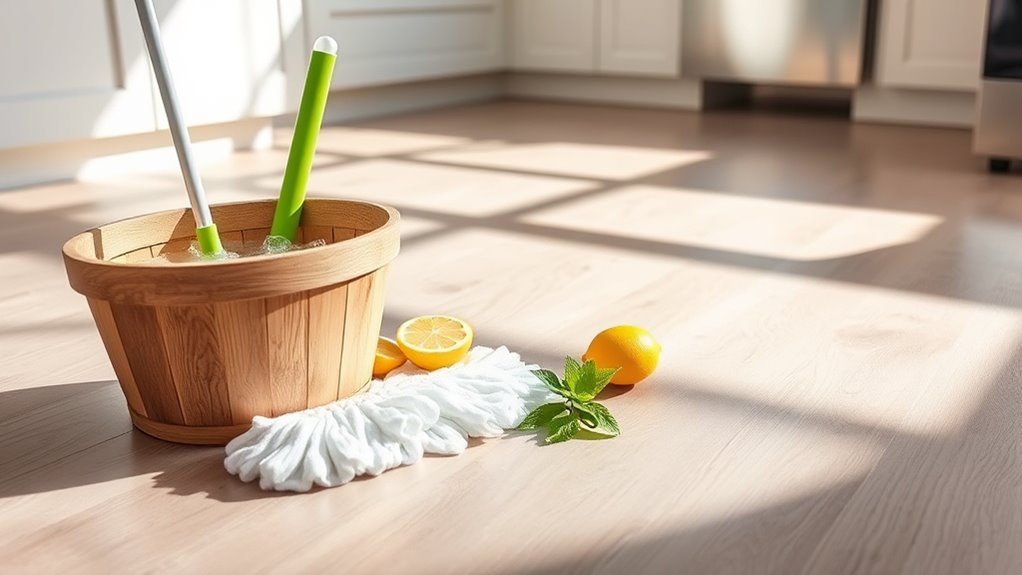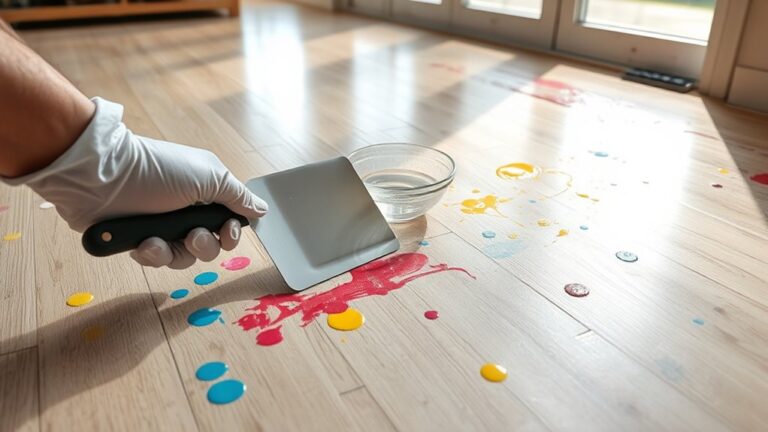To clean your laminate floors naturally, start by gathering eco-friendly supplies like white vinegar, baking soda, and microfiber cloths. Sweep or vacuum to remove dirt gently, then mop with a vinegar-water solution for a streak-free shine. For tough spots, use a baking soda paste, and always dry the floor quickly to prevent damage. Regular dusting and protective pads under furniture help maintain your floor’s beauty. Explore simple steps to keep your laminate floors looking fresh and lasting longer.
Gather Natural Cleaning Supplies
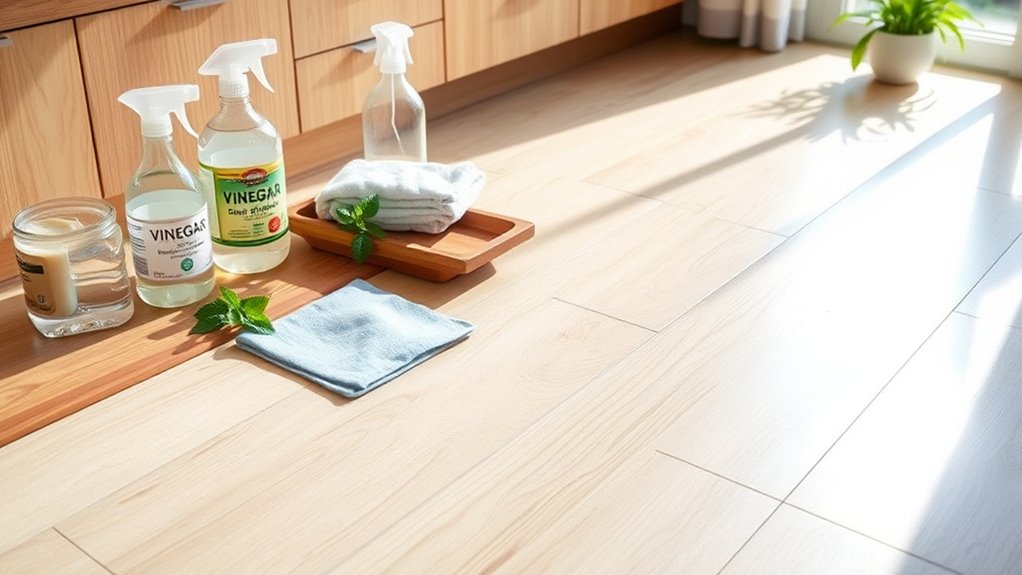
Before you begin cleaning, you’ll want to gather a few natural supplies that are safe for laminate floors. Choosing eco friendly alternatives helps protect your home environment while maintaining your freedom from harsh chemicals. Start with simple items like white vinegar, baking soda, and essential oils—these are the core ingredients for many effective homemade cleaners. You’ll also need a soft microfiber mop or cloth to avoid scratching the vloer‘s surface. Avoid abrasive tools or harsh detergents, as they can damage laminate finishes. By assembling these natural supplies, you’re ready to clean confidently and responsibly, ensuring your floors stay spotless without compromising your health or the planet. This approach lets you maintain your space with ease, using gentle, sustainable solutions you can trust.
Prepare a Gentle Cleaning Solution
To prepare a gentle cleaning solution, mix one cup of white vinegar with a gallon of warm water. This blend uses gentle ingredients, ensuring your laminate floors stay protected without harsh chemicals. Vinegar acts as a natural disinfectant, cutting through grime while preserving your floor’s finish. If you prefer, add a few drops of essential oil for a fresh scent without sacrificing eco friendly options. Avoid using soap or abrasive cleaners, as they can leave residue or damage the surface. This simple, effective mixture respects both your home and the environment, granting you the freedom to maintain clean, beautiful floors naturally. Keep your solution ready in a spray bottle or bucket for easy access during your cleaning routine.
Sweep or Vacuum the Floor Thoroughly
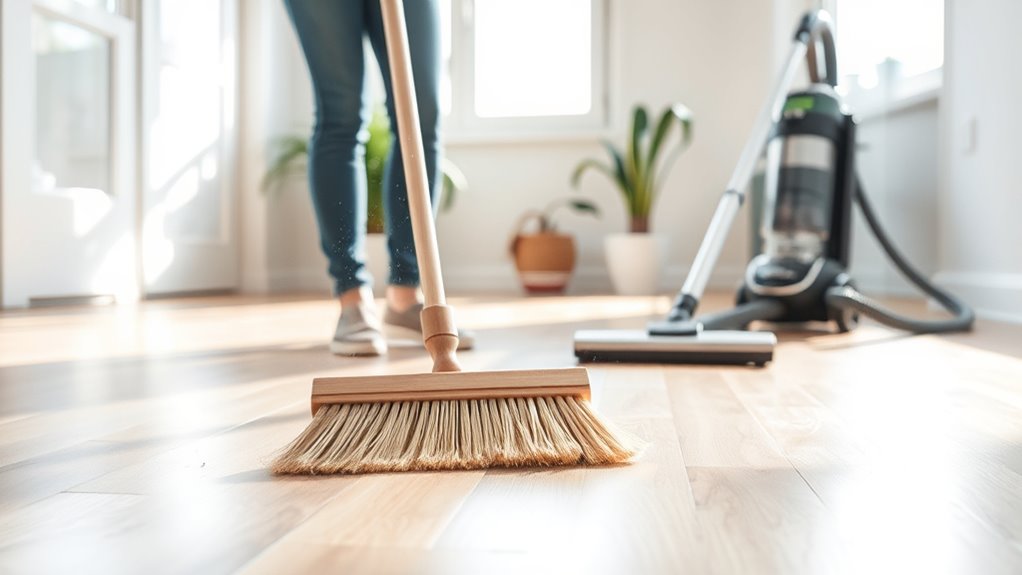
Although it might seem simple, sweeping or vacuuming your laminate floors thoroughly is essential to remove dirt and debris that can scratch or dull the surface. Start with effective sweeping techniques: use a soft-bristle broom to gently gather dust and particles without damaging the floor. Sweep in one direction to avoid scattering debris. If you prefer vacuuming, choose a vacuum with a hard floor setting or a brush attachment designed for laminate floors. Vacuum slowly and carefully to pick up fine dust and grit. Avoid vacuums with beater bars, as they can scratch the surface. Regularly cleaning your floors this way helps maintain their natural shine and extends their life, giving you the freedom to enjoy a clean, scratch-free space.
Mop Using a Damp Microfiber Cloth
Once you’ve removed loose dirt with sweeping or vacuuming, the next step is mopping to lift any remaining grime without damaging your laminate floors. Use a microfiber cloth dampened with water; this method offers microfiber advantages like superior dirt trapping and gentle cleaning. Avoid soaking the cloth—excess water can seep into seams, causing warping or swelling. Damp cleaning is effective because it loosens dirt while protecting your floor’s finish. Move the cloth in smooth, even strokes, rinsing and wringing it frequently to prevent redistributing dirt. This approach keeps your laminate safe and looking fresh, giving you freedom from harsh chemicals and excessive moisture. By choosing a damp microfiber mop, you maintain your floors naturally and efficiently.
Target Stubborn Spots With Baking Soda Paste
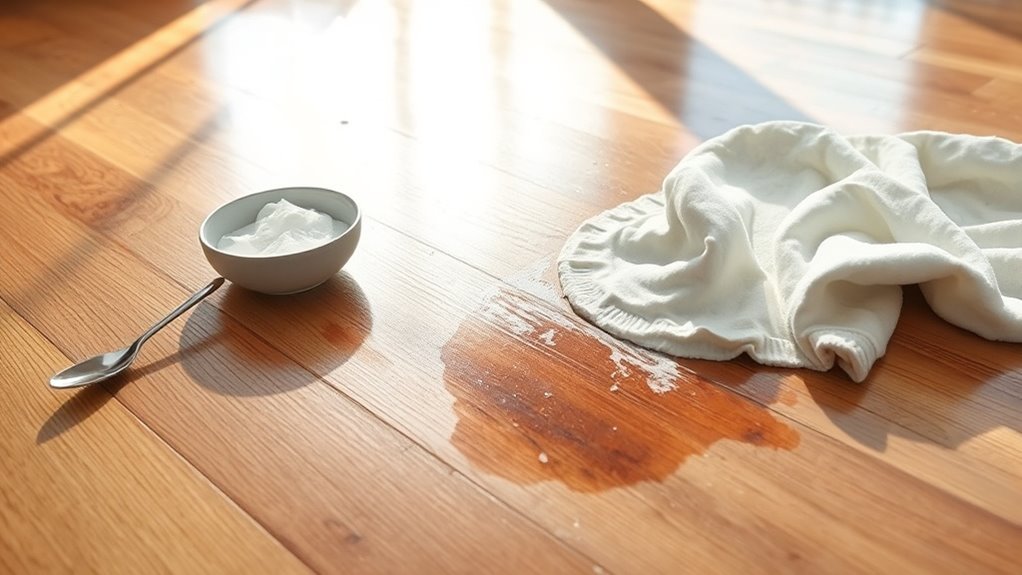
When stubborn spots resist damp mopping, you can tackle them effectively with a baking soda paste. Mix baking soda with water until it forms a thick paste. Apply it directly to the stain, let it sit for 5-10 minutes, then gently scrub with a soft cloth or sponge. This natural method excels in stain removal without harsh chemicals.
| Stubborn Spot Type | Baking Soda Application | Scrubbing Tool |
|---|---|---|
| Grease | Paste + 10 min sit | Soft cloth |
| Ink | Paste + 5 min sit | Soft-bristle brush |
| Food stains | Paste + 10 min sit | Sponge |
| Scuff marks | Paste + 5 min sit | Soft cloth |
This approach frees you from chemical cleaners while keeping your laminate floor spotless.
Dry the Floor to Prevent Water Damage
Because laminate floors are sensitive to moisture, you should always dry them thoroughly after cleaning to prevent water damage. Don’t let water sit on the surface—excess moisture can seep into seams and cause swelling or warping. Use a clean, dry microfiber cloth or a mop with a dry head to absorb any remaining dampness. Focus on corners and edges where water tends to accumulate. Quick and effective floor drying protects your investment and keeps your floors looking flawless. Avoid air-drying alone, as it’s often too slow and increases the risk of damage. By prioritizing thorough drying after every cleaning session, you maintain the floor’s integrity and enjoy a lasting, beautiful finish without worry.
Maintain Shine With a Vinegar Rinse
You can keep your laminate floors shining naturally by using a vinegar rinse, which helps remove residue and restore gloss without harsh chemicals. To prepare, mix one cup of white vinegar with a gallon of warm water. Apply the solution with a damp mop, making sure not to oversaturate the floor for the best results.
Benefits of Vinegar Rinse
A vinegar rinse offers a simple, natural way to maintain the shine of your laminate floors without harsh chemicals. One of the key vinegar benefits is its ability to break down dirt and grime while leaving a streak-free finish. This means you can avoid synthetic cleaners that often dull the surface over time. Vinegar’s mild acidity gently enhances your floor’s shine, restoring its original luster without causing damage. Plus, it naturally deodorizes, keeping your space fresh and inviting. Using a vinegar rinse regularly supports long-term shine enhancement, helping your floors look vibrant without extra effort. It’s an effective, eco-friendly choice that aligns with your desire for freedom from harsh toxins and complicated cleaning routines.
How to Prepare Solution
Maintaining your laminate floor’s shine with a vinegar rinse starts by preparing the right cleaning solution. The ideal solution ratio is one cup of distilled white vinegar mixed with one gallon of warm water. This balance guarantees effective cleaning without damaging the floor’s protective layer. Avoid using undiluted vinegar, as it can dull the finish over time. For best results, adjust the cleaning frequency based on your lifestyle—once every one to two weeks works well for most homes. If you have pets or children, you might want to increase this frequency slightly. Always mix fresh batches before each use to preserve the vinegar’s cleaning power. By following these solution ratios and cleaning frequency guidelines, you’ll keep your laminate floors looking naturally vibrant and free from buildup.
Application Tips for Shine
Although the vinegar rinse is gentle, applying it correctly guarantees your laminate floor stays shiny without damage. For peak shine enhancement, dilute vinegar with water—never use it full strength. Use a microfiber mop to lightly apply the solution, avoiding overwetting. This method acts as a natural polish, protecting your floor’s surface and maintaining its luster.
| Stap | Actie | Doel |
|---|---|---|
| 1 | Mix vinegar & water | Safe, effective rinse |
| 2 | Use microfiber mop | Gentle application |
| 3 | Avoid soaking floor | Prevent damage |
| 4 | Mop in sections | Even coverage |
| 5 | Air dry thoroughly | Preserve shine |
Following these tips guarantees your laminate floors stay vibrant and naturally polished.
Tips for Regular Natural Floor Care
To keep your laminate floors looking their best, make daily dusting a habit using a microfiber mop or soft broom. Incorporate natural cleaning solutions like diluted vinegar or gentle castile soap for regular mopping. Finally, protect your floors by placing felt pads under furniture and avoiding excessive water to prevent damage.
Daily Dusting Techniques
Even if you clean your laminate floors regularly, dust can quickly accumulate and dull their appearance. To maintain that fresh look, establish a regular schedule for daily dusting. Using effective dusting tools like microfiber mops or electrostatic dusters will trap dust without scratching the surface. Avoid traditional brooms that might scatter dust or cause minor damage. Make it a habit to dust high-traffic areas and corners where dust tends to gather. By staying consistent, you prevent buildup that leads to dullness and wear. This simple step keeps your floors looking vibrant and extends their lifespan, giving you the freedom to enjoy a clean, natural home environment without harsh chemicals or extra effort.
Natuurlijke schoonmaakoplossingen
Keeping dust at bay sets a solid foundation for deeper cleaning with natural solutions that protect your laminate floors. To maintain that fresh look, opt for eco friendly products or homemade cleaners made from simple ingredients like vinegar, water, and a few drops of essential oil. These solutions effectively remove dirt without damaging the floor’s finish. Mix one cup of white vinegar with a gallon of warm water for a gentle yet powerful cleaner. Use a damp mop rather than soaking your floors to avoid moisture damage. Regularly using these natural cleaners helps preserve your floor’s shine and extends its lifespan while keeping your home chemical-free. By choosing eco friendly options, you embrace a healthier lifestyle and maintain your freedom from harsh chemicals.
Preventive Floor Maintenance
Three simple habits can make a big difference in preserving your laminate floors naturally. First, always use doormats to trap dirt and grit, preventing scratches and wear. Second, place felt pads under furniture legs to avoid dents and scuffs when moving items. Third, clean spills immediately with a soft, damp cloth to prevent moisture damage. These preventive measures support floor longevity by reducing the need for harsh cleaning or repairs. Avoid excessive water when cleaning—moisture can seep into seams and cause swelling. Regular sweeping or vacuuming with a soft brush attachment keeps dust and debris from accumulating. By adopting these easy habits, you maintain your floor’s appearance and durability naturally, giving you the freedom to enjoy your space without worry.

